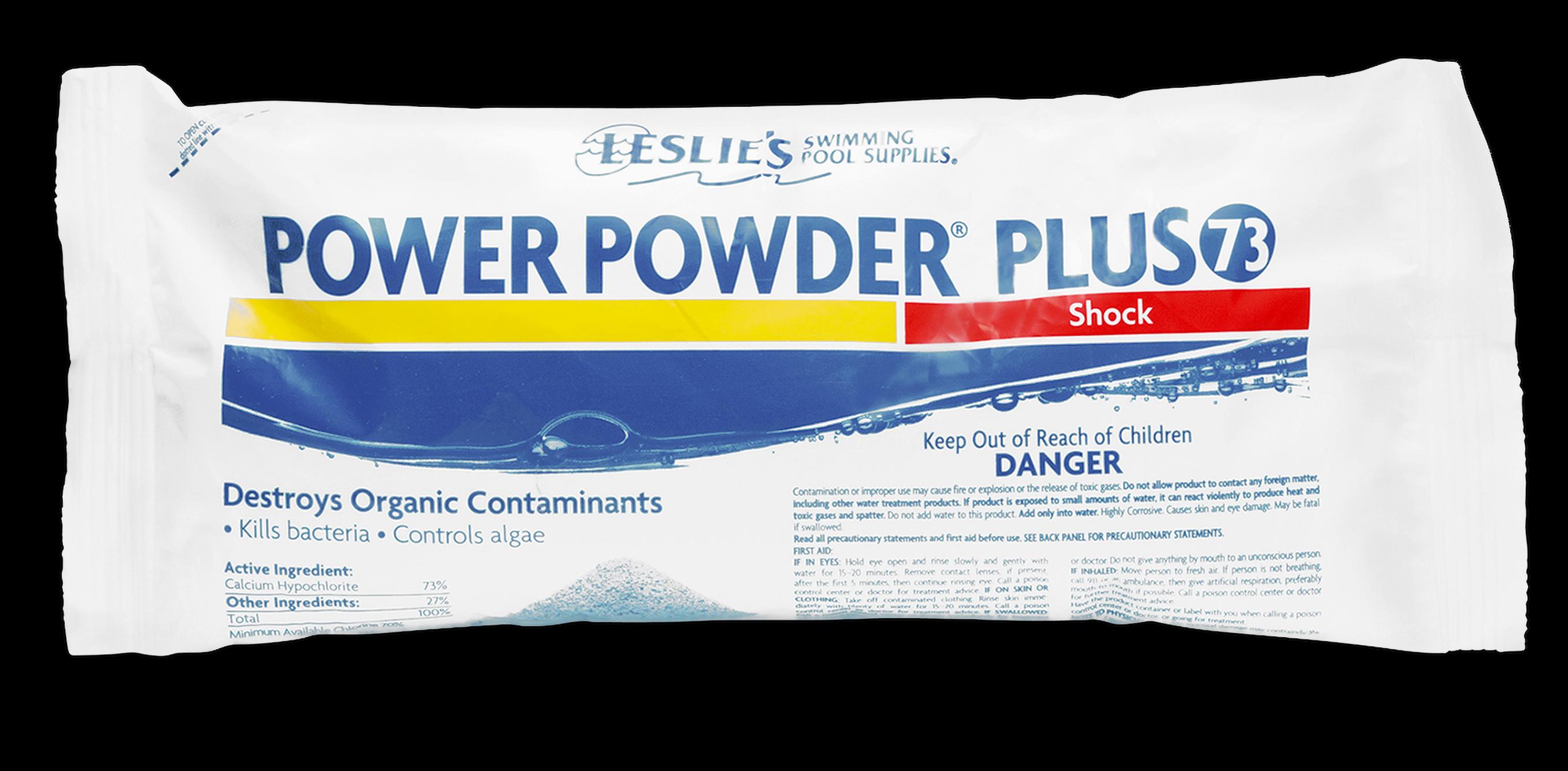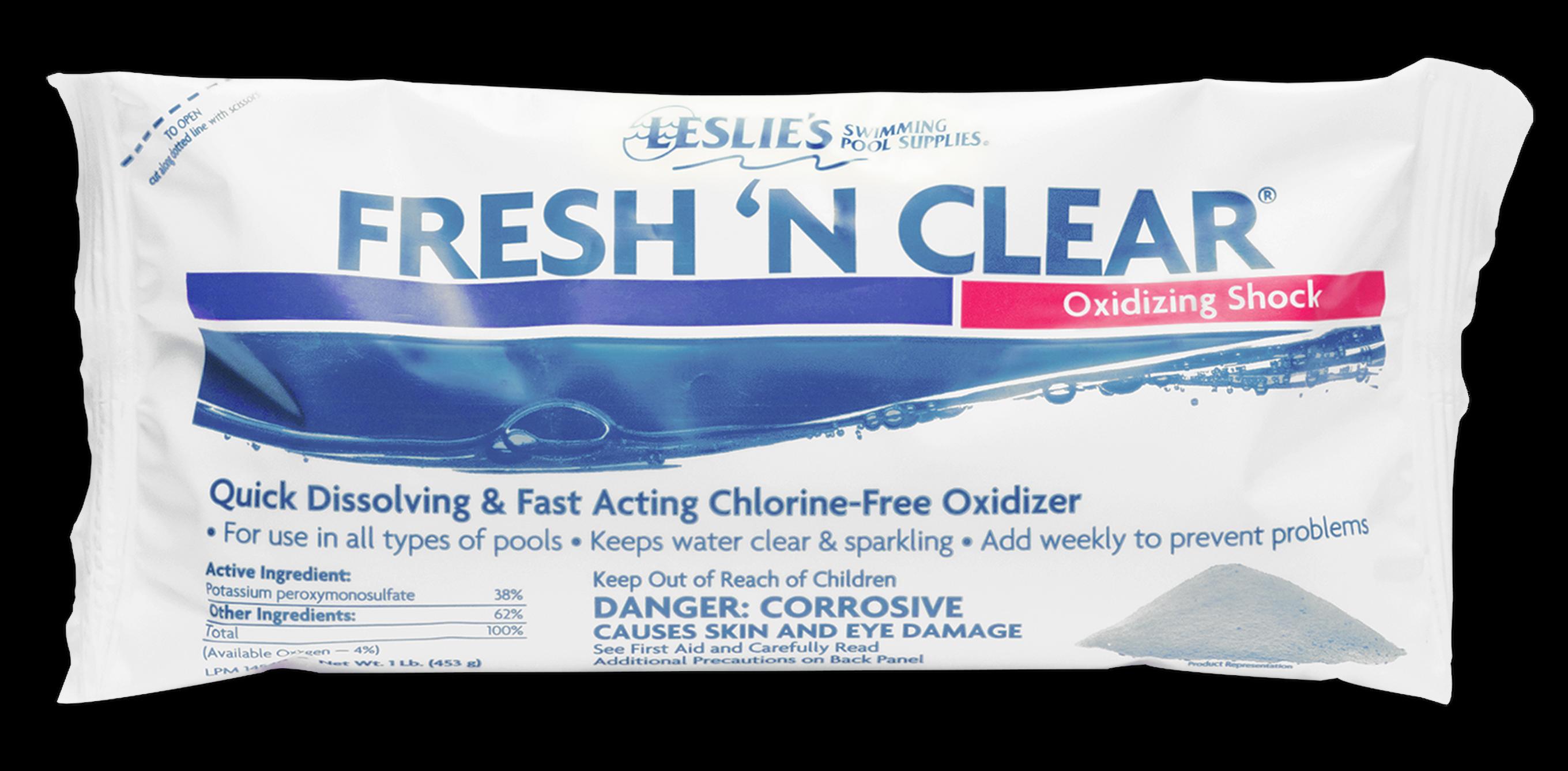Pool Shock
25 results
| Type | Dosage |
|---|---|
| Chlor Brite |
Routine Treatment: 3 oz. treats 10,000 gallons. Superchlorination: 11 oz. treats 10,000 gallons. Algae Control: 21 oz. treats 10,000 gallons. |
| Power Powder Plus |
Superchlorination: 9-18 oz. treats 10,000 gallons. |
| Fresh 'N Clear |
Initial Treatment: 2 lb. treats 10,000 gallons. Weekly Treatment: 1 lb. treats 10,000 gallons. |
| ☀ | Chlor Brite | Power Powder | Fresh 'N Clear |
|---|---|---|---|
| Removes Organics | ⚫ | ⚫ | ⚫ |
| Swim After 15 Minutes | ⚪ | ⚪ | ⚫ |
| Includes CYA | ⚫ | ⚪ | ⚪ |
| Near-Neutral pH | ⚫ | ⚪ | ⚫ |
| Adds To Hardness | ⚪ | ⚫ | ⚪ |
| Contains Clarifier | ⚪ | ⚪ | ⚫ |
| Bromine Compatible | ⚫ | ⚫ | ⚫ |
| Ideal Pool Type | Salt & Liquid Chlorine Pools | Tablet Chlorine Pools | All Pools & Spas |
Chloramines: Combined Available Chlorine (CAC), or Chloramines, are formed when your Free Available Chlorine (FAC) becomes tied up with contaminants such as sweat, fertilizer, dirt, rain, bodily fluids, and pollution. Some of these contaminants contain ammonia and organic or inorganic nitrogen compounds. CAC is a weak sanitizer (40-60 times less effective than FAC) and causes a chlorine-ammonia odor. It also irritates the nose, eyes and skin of swimmers. Weekly shocking will prevent and remove chloramines, which restores more FAC effectiveness to your pool.
Opening & Closing: When opening your pool, it's recommended that you shock your pool after balancing the other chemicals. This will oxidize the particles, kill bacteria, and clarify the water. When it's time to close your pool, shocking will help fight off contaminants over the long winter months.
Rain & Thunderstorms: During storms, your pool is likely to be contaminated by rain water, dust, and other debris. Shocking after severe weather will help clean up after Mother Nature.
Algae Outbreaks: When algae appears in your pool, superchlorination with powerful types of shock like Power Powder Pro or other variations of Cal-Hypo can often eliminate the problem.
Heavy Pool Usage: When pools are used by a large number of people in a short amount of time, the water can become contaminated in a variety of ways. Shocking after pool parties or other unexpected contaminations is highly recommmended.
Which Type Of Shock Should I Use?
Each of our three types of shock excel in different types of pools. Chlor Brite is perfect for saltwater pool and pools with vinyl liners or other sensitive surfaces because of it's nearly-neutral pH level. It also dissolves quickly and won't cloud water. Power Powder is our most powerful form of shock, and as a result, it's perfect for eliminating algae blooms and other major contaminants. It does, however, have a high pH, which could damage more sensitive pool surfaces like vinyl. Fresh 'N' Clear is a chlorine-free shock that oxidizes non-living organic contaminants, increasing the effectiveness of the Free Available Chlorine (FAC) in your pool water. That said, because it doesn't contain any chlorine, it's not useful for treating algae or killing germs by itself.
How Long Does Pool Shock Last?
The shelf life of pool shock can vary depending upon how and where it's stored. If stored in a cool, dry, and dark location, your shock will remain usable for years to come. If stored in the heat, however, it will quickly solidify and become useless. For longer and safer storage, purchase your shock in buckets, then store them in cooler places.
Why Did Shock Make My Water Cloudy?
Because it takes longer to dissolve than other pool shocks, Power Powder can temporarily cloud your water depending upon the type of Power Powder used and preexisting water conditions. This is normal, and the cloudiness should disappear after the shock dissolves.
Shocking Tips
- Balance your pH to 7.2 - 7.4 prior to shocking.
- Don't mix pool shock with any other pool chemical.
- Never pour shock directly into your skimmer.
- Shock your pool at night to reduce UV degradation.
- Run your pool filter for at least 8 hours after shocking.
- Shock again if chlorine levels remain at 0 after 8 hours.


